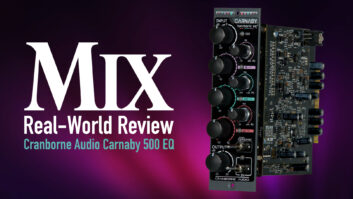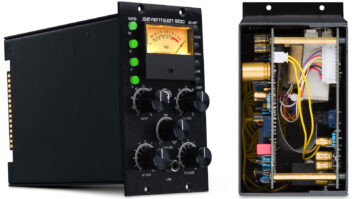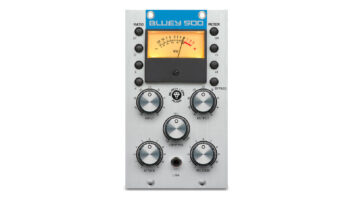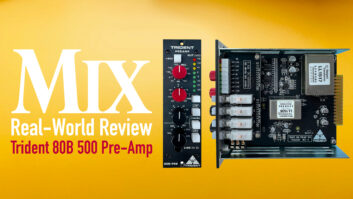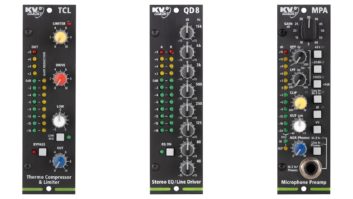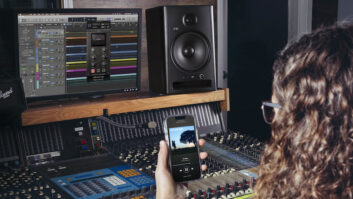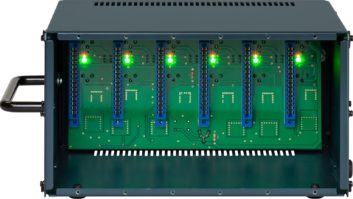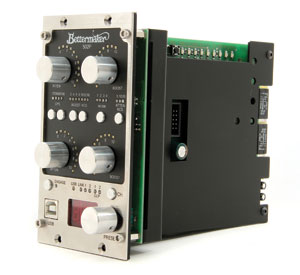
Over the past two years, 500 Series preamps and processors have matured in design sophistication and sonics. Processors such as the Empirical Labs DocDerr, Elysia nvelope and xfilter have set the bar high, and others have answered the call. The two units reviewed here offer a unique look at EQ for the format and will ring the bell of those looking to step beyond plug-ins into hardware solutions. Both have their strengths and unique features that put them in the best-in-class category.
Bettermaker EQ502P
Bettermaker EQ502P
This beefy and shiny doublewide 500 Series unit created in Poland by Marek Walaszek and the Bettermaker team takes a design cue from Pultec’s EQP-1A and Bettermaker’s own rackmount EQ232P. It steps up the 500 Series workflow by adding digital control. With a free plug-in, you can control the unit via USB and even write automation.
The front controls are simple. The unit is broken into HF and LF sections with separate Boost and Atten controls for each frequency (±14 units based on Pultec measurements). You get four LF choices and seven HF, plus a basic four-level HF bandwidth control (1 narrow to 4 wide), and extra Atten at 5, 10 and 20 KCS. This last bit is great for boosting using the HF control but cutting the absolute top, or high-mid range or vice versa. This is versatility defined in a simple set of controls and is why the Pultec design from the 1950s is coveted and used to this day.
Unlike the Pultec, however, with the EQ502P, if you find something you love you can recall it with laser-like accuracy by storing a setting in the hardware or in the plug-in.
The rotary knob on the front of the unit allows you to store and recall 399 user presets. The interface is simple and easy to get your head around. To save a setting, push and hold the rotary control for two seconds. When you see No, rotate the knob to Yes and tap the button once to store it. Recall and zeroing the unit is just as easy—you just tap the knob once to recall a setting and twice to return the controls to zero. Made a mistake and zotzed your setting? Rotate the knob to 400 and recall it by tapping once. The hardware has one level of undo in case you accidentally clear the unit or recall another preset.
I installed the unit into slots 7 and 8 of my Radial Workhorse 500 Series rack. I patched a bass across the left channel but heard a loud pop each time I cycled through the controls and bypass. The Radial slots are rated at 150mA if power is distributed evenly across all eight slots, but I believe units in place before the Bettermaker were sucking the power that this beast needed. Once I moved the EQ502P to slots 1 and 2, all was well. Again I patched the Pro Tools output of my bass track into the left channel of the Bettermaker, then out into a Dangerous 2 Bus for monitoring. I chose 60 Hz and cranked up the LF Boost knob. Rich bottom end sprang forth, making the bass spread across the bottom of the track—just where it belonged.
Next I tried the EQ502P in stereo mode across drum overheads. I set the BW to 4 for a wide cue, then boosted 10k. Although the band is a bell, because the unit goes out to 40k you can create a shelf by choosing a higher frequency that puts the right hand slope of the bell beyond Nyquist. I then kicked the HF down to 5 kHz, which worked great. Even at the extremes of 14 dB of boost, the EQ still sounded natural, not strident. This is a very musical box.
I tried the Bettermaker across a range of applications, but one of my favorites was on raging guitars. I recorded a Marshall 4×12 cabinet gassed by a JCM800 head using a Royer R-121 and Coles 4030L, two ribbon mics that are very complementary. For the mix, I bused them both across a channel of the EQ502P, set the BW to narrow and boosted 3 kHz. I also cut at 5 kHz, which gave me more control of the slope. The Bettermaker had all the gain I needed to channel AC/DC into the track.
You might think that the EQ502P is pricey at $800 a channel, and you’d be right. But for what it can do both sonically and with digital controls you can automate in your DAW, it’s worth it. Highly recommended.

Maag Audio EQ2 500
Maag Audio EQ2
The Maag EQ2 is a different take on EQ. It’s a simple 2-band, single-space 500 Series unit with 11 pre-chosen frequencies in the LMF band and six shelving choices in the Air Band. I fell in love with Maag’s approach way back when the now-discontinued NTI EQ3 Nightpro was released. Both units offer designer Cliff Maag’s frequency choices and Air Band, which boosts out to 40k, adding a deliciously silky top end to cymbals, hand percussion and other items you want to sit in that area of a mix.
The EQ2 brings this and more to your 500 rack. I had two for the review, which gave me the luxury of stereo options. One of the best features is the input attenuator, which is essential for DAW use and a feature I’d like to see on other 500 Series units. It’s a lifesaver when you’re boosting and need that extra chance to trim the output before it hits your converters on the way in.
Other features include an in/out button on each band and a handy wide/narrow cue switch that slightly alters the frequencies and bandwidth in the LMF band. For instance, you can boost at wide Q at 220 Hz or switch to narrow band at 150 Hz. Some other swappable choices in this fashion are between 400 Hz/250 Hz and 1.4 kHz/1 kHz, which are very musical.
I used the EQ2 on a number of applications but loved them on screaming guitars. I spent a week cutting a Marshall stack recently and used the Maag extensively to sculpt the tones. I found myself leaning toward boosting 2.5 kHz at the top and 400 Hz at the bottom. The Maag could dish it out at nearly full gain and sounded great to the edge of too much. I found myself wishing for one more choice at the Air Band at 1.4 kHz or so, but nonetheless, the choices available were great.
The EQ2 excelled on acoustic guitars, as well as drum overheads and individual drums like snare and toms. I liked how the wide/narrow switch gave me some extra choices and offered subtle differences in how much area I was covering at a chosen frequency—it’s a very usable feature. The only thing I really pined for when using the EQ2 was the ability to cut as well as boost. The addition of this capability would really bring the EQ2 to the next level. That said, this is a great-sounding 500 Series EQ and one you can easily fall for. It is quality-built throughout, sounds like no other EQ and just works. What’s not to love?
Product Summary
COMPANY: Bettermaker
PRODUCT: EQ502P
WEBSITE:www.bettermaker.eu
PRICE: $1,595
PROS: Great sound, digital control of analog hardware.
CONS: Numbers on front of unit are tiny and tightly spaced.
TRY THIS
When mixing, patch the 502P across your drum overheads, zero the unit by double tapping the Preset knob, then put it in Linked mode. Set the Boost KCS to 5 and gently boost the High Frequency control to taste. Don’t be afraid to crank it if you need it; this unit sounds great all the way to 10. Reprint the track with the EQ, then repurpose it for your bass track. Zero the unit, patch your bass into a channel, boost 60 or 100 Hz to taste, print it. Rinse, lather and repeat.
Product Summary
COMPANY: Maag Audio
PRODUCT: EQ2
WEBSITE:www.maagaudio.com
PRICE: $599
PROS: Versatile frequency controls. Input gain control.
CONS: No cut, just boost.
TRY THIS
When you want guitars to shred through any mix, set the Air Band to 2.5k and crank up the gain until you love it. The EQ2 sounds great out to the fringes. In this application, the bottom band at 400 Hz gives you some excellent body to pair with the beautiful buzzsaw you’re creating in the upper mids. Flip the cue/alternate frequency control back and forth and hear the subtle differences this makes.

